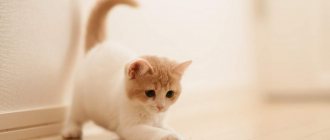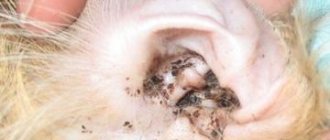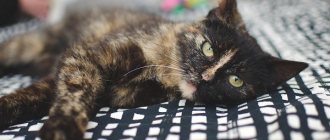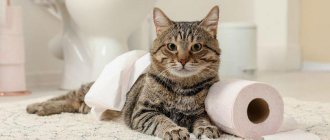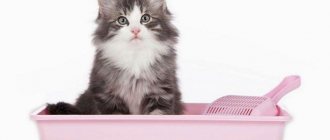If the kitten is healthy, this is immediately obvious: it constantly runs, climbs into strange places, hunts for enemies visible only to it, or for birds in the window.
Like human children, cat babies cannot plan their energy distribution. The kids will play and fuss until they fall asleep right there, buried in their toys.
How to properly give an enema to a small kitten.
How to properly give an enema to a small kitten.
How to properly give an enema to a small kitten.
How to properly give an enema to a small kitten.
A balanced diet is very important for a growing body. The kitten's body is very sensitive and demanding of food. Anything that goes wrong immediately results in either diarrhea or constipation.
A conscientious owner should pay special attention to choosing the right food for a small kitten.
But if constipation occurs, you need to know how to get rid of it gently and safely.
Causes of constipation
With prolonged feeding of solid food and a sedentary lifestyle, stagnation of chyme mass may form in the small intestine. This is the semi-digested contents of the kitten's stomach.
This phenomenon is called chemostasis.
If a kitten is fed bones, a plug of dry feces may form in the small intestine. It will clog the lumen and reduce intestinal permeability to zero.
The intestines can become blocked by accidentally swallowed objects, hairballs, or worms.
What solutions are used
Medicinal enemas are selected exclusively by a veterinarian.
There are several options for cleansing compositions for home use, but you should also consult your doctor about each of them.
Enema solutions for constipation in cats
| Name | Peculiarities |
| Saline | Dilute in a proportion of 1 liter of warm water and 30 g of table salt. The enema is administered in small portions - 50 ml each |
| With magnesia | In this embodiment, the saline solution is prepared differently:
Cool to the optimal temperature and administer to the animal. |
| Soapy | Dissolve 1 tbsp in 1 liter of water. grated soap. It is recommended to take either light household or children's clothes - they do not contain harmful additives or dyes |
| Herbal | Chamomile infusion is best suited for an enema. Steam 1 tbsp with boiling water (1 l). or a packet of herbal powder. Leave for half an hour, then filter through several layers of gauze. |
| Glycerin | The product (1 tbsp) is poured into 1 liter of warm water, stirred and immediately filled with a syringe with the solution. |
Any of the compositions may be unsafe for your pet: the cat may have contraindications to one of the components of the cleansing enema.
Before choosing the appropriate option, you must contact your veterinarian.
Other reasons for an enema
An enema is not only done to relieve constipation. Indications may also include poisoning or severe exhaustion. In the first case, it is needed to quickly remove harmful substances from the body. And in the second - to quickly feed the kitten if it cannot eat.
Enemas can also be medicinal, when it is not possible to administer the medicine in any other way, and relaxing - to relieve intestinal spasms.
How to properly give an enema to a small kitten.
How to properly give an enema to a small kitten.
How to properly give an enema to a small kitten.
How to properly give an enema to a small kitten.
Prevention of fecal impaction
To avoid excesses with difficulty defecating, try to follow the following recommendations:
- Provide your pet with a balanced diet, do not allow sudden changes in the diet, do not treat the fluffy with delicacies from the master’s table (smoked meats, pastries, sausages);
- avoid purchasing cheap dry food, choose a super premium option;
- Make sure your pet has enough fluids;
- To prevent constipation from occurring in old cats, examine them regularly and treat them promptly; once a year, with the “blessing of the veterinarian,” you can take a preventive course of Dufelax;
- To remove hair that enters the animal’s body, it is recommended to give it a special paste.
If your pet is well cared for, problems with bowel movements will be rare. The owner of a meowing creature needs to understand that hard stools can be a manifestation of a serious illness.
Not all cat problems can be solved with Vaseline oil or an enema. These are first aid products for home use. This should be followed by a visit to the clinic, examination and elimination of the cause of the intestinal problems.
Don't forget to click Class! CoolTweetSharePlusShareSendWhatsAppPinBack
How to do an enema yourself
First of all, you must be sure that an enema is necessary and that constipation is not caused by volvulus or obstruction.
It is best to use a small bulb, although you can make an enema with a large syringe with a wide hole.
All procedures should be performed in the bathroom or on the bare floor so that it can be easily washed later. There should be a cat litter box nearby. And stock up on napkins or unnecessary rags.
The water in the pear should be warm. For lubrication, use Vaseline, baby cream or regular vegetable oil.
When everything is ready, place the kitten on your lap with its muzzle facing you, holding its head and back between your legs. Be careful: you should measure your strength with the size of the kitten. Make sure he can't escape and at the same time don't choke him.
Lift the kitten's tail, lubricate the anus with Vaseline and insert the tip of the bulb into the rectum. It is enough to immerse it 1-2 cm. Gently press the bulb and pour the water from it into the kitten. The volume of water should be in the range of 50-100 ml.
Then remove the bulb, gently squeezing the anal folds so that the water does not flow out immediately. If the kitten allows, you can lightly massage its tummy to enhance the effect.
After the procedure, do not let the kitten run around the apartment or hide in other rooms. Keep him in the same room as the litter box. So that he can easily reach it (perhaps with your help) when he wants to go to the toilet.
Types and required solution
If the pet is still small, then a syringe is suitable for the procedure.
In veterinary practice, there are two types of enema. It can be medicinal and cleansing. If we are talking about the latter, then it is prescribed to eliminate feces from the intestines. The solutions used during the manipulation process dilute feces, improve peristalsis and remove feces. A medicinal procedure is required to introduce medications into the large intestine for the purpose of local treatment. This enema is mainly used if the cat is diagnosed with inflammatory diseases of the gastrointestinal tract. If we talk about devices for an enema, then you can do it at home for newborn kittens with a syringe. It is recommended that older animals receive an enema using a bulb with a rubber tip, which can be purchased at pharmacy chains. A procedure using water and Vaseline oil will help cleanse the intestines. The volume of the first component is 100 ml, the second ingredient will need to take 2 tablespoons. It is better to pre-heat the oil in a water bath, which will give the maximum effect of the manipulation. A procedure with medicinal chamomile, which has anti-inflammatory properties and effectively fights parasites, can also be prescribed. To prepare the product, you will need to take 150 ml of water, 2 tablespoons of chamomile flowers and boil the composition.
It's easier with an assistant
If you have a helper, trust him to hold the kitten. And carry out all the procedures yourself. This will free up your hands and make it more convenient.
How to properly give an enema to a small kitten.
How to properly give an enema to a small kitten.
How to properly give an enema to a small kitten.
How to properly give an enema to a small kitten.
Contraindications
When infusing liquid, albeit under slight pressure, the intestinal walls can be damaged by a tool or by stretching.
And since the cat has to be given an enema by force, the risks increase - the pet, instead of the necessary relaxation, violently resists. It will not be possible to secure an adult animal without an assistant. You should not carry out the procedure yourself if the cat is weakened, suffers from fever, uncontrollable vomiting, or dizziness. Contraindications for performing an enema on a cat:
- hemorrhoids in the acute phase, anal fissures
- tumors, erosions, intestinal prolapse
- the first day after abdominal surgery
- gastrointestinal bleeding
- abdominal pain of unknown cause
- volvulus, intestinal obstruction of any etiology
- high blood pressure, heart disease, stroke
Before giving an enema to a kitten, it must be weighed. Babies lighter than 300 g are administered only microdoses of solutions strictly as prescribed by the doctor. If there is an obstruction, when a large volume of fluid is injected, there is a high probability of wall rupture. Pressure increases intestinal bleeding. These two side effects can lead to death.
General information
Constipation is a pathological condition in which feces in the large intestine of an animal are not excreted into the external environment, but remain in the lumen of the organ. There they are “rammed”, compacted, and the body sucks out all or almost all the moisture from them. In addition, “old” feces are a constant source of strong toxins that are continuously absorbed into the blood and poison the animal’s body. The intoxication that appears as a result of this process can be so strong that with chronic constipation, a cat can vomit foamy masses, and the likelihood of developing kidney and heart failure increases by more than 70%.
Finally, “petrified” feces are so hard that they can mechanically damage the intestinal walls. Because of this, a sick cat is likely to develop sepsis, since the damaged mucous membranes of the organ can no longer prevent the penetration of pathogenic and conditionally pathogenic microflora into the general bloodstream.
Note that constipation is not a unique pathology at all, and it can also occur in animals that have not previously suffered from digestive disorders. Particular problems arise for owners who have several animals living in their house: it can be difficult to find out which cat has developed constipation.
But there is one trick - you can feed the cats (alternately) beet-based baby food. This product is capable of coloring feces in a specific, easily recognizable color. Please note that as a result of its use, not only the feces, but also the animal’s urine will acquire a reddish tint. Thus, given the special color of the feces, you can easily determine which of your pets the dry feces belong to. If a cat fed with beets does not defecate at all, you will also quickly find out about this.
